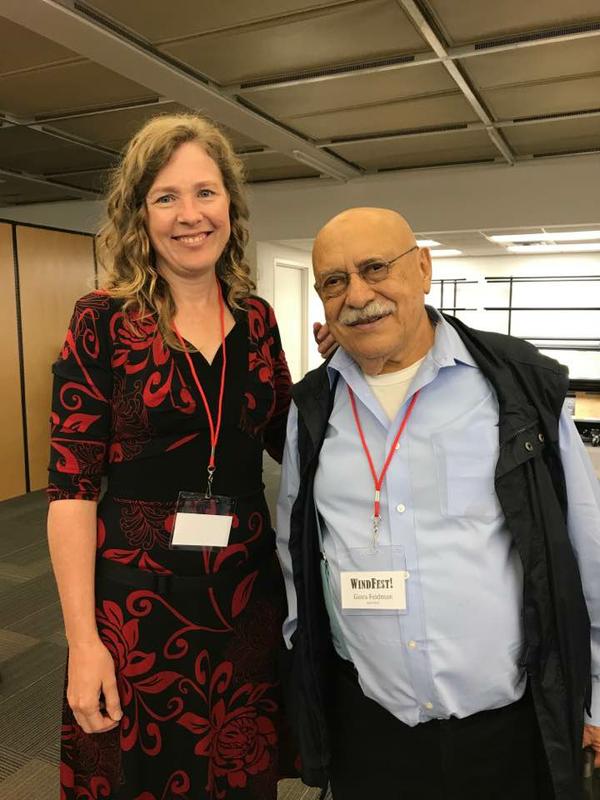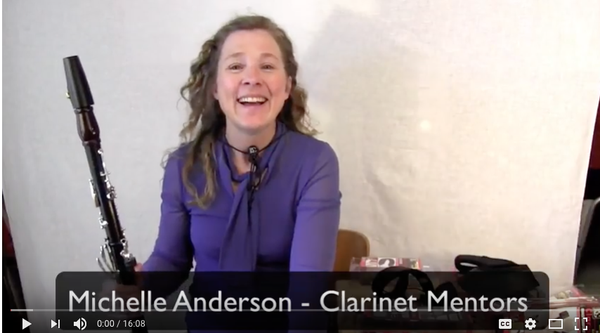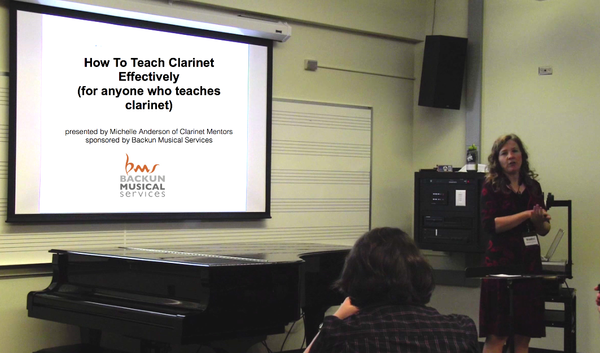Oct 2017 - Keep your hands and fingers in shape much longer

In This Issue
October 11, 2017
- A Note From Michelle Anderson - Happy Canadian Thanksgiving!
- Free Training - The Biggest Health Complaint from Clarinetists? - Hand/Finger problems! - Here is a comprehensive look at one set of tools that can help
- Free Training for Clarinet Teachers (but also great advice for players too) - Michelle's presentation on How To Teach Clarinet More Effectively
- Michelle Recommends - BG Brace Comfort Strap
- Further Clarinet Training - If you just want to scroll to the bottom and find out how Michelle can help you play more easily with her step-by-step courses, jump here
Hello From Michelle Anderson
Hello !
Welcome to the Clarinet Mentors newsletter, and I thank you for being a part of this wonderful, worldwide, community of enthusiastic clarinetists. It is very exciting to be part of a group of thousands of clarinetist from around the world, who all enjoy making music.
This past weekend was Thanksgiving in Canada, and I am thankful for all of you. We hosted a wonderful gathering that included many friends, good food, and a crazy late night sing-along. On Thanksgiving Day, I had a long rehearsal for performing the powerful Turandot by Puccini with the Vancouver Opera. What an amazing piece of music, especially with a great cast and a huge chorus and orchestra. As our conductor said, "We should all be thankful that we can make such great music (and be paid for it)"
I had the pleasure of presenting at the University Of British Columbia WindFest 2017 two weeks ago. This event featured many flute and clarinet related activities. In particular, I enjoyed hearing Jose Franch-Ballester perform and give a master class. He has joined the faculty at UBC, and is a huge new presence in the clarinet community here in Vancouver. I also had the pleasure of meeting legendary clarinetist Giora Feldman, who gave a very thoughtful presentation about his clarinet philosophies.
My presentation focused on How To Teach Clarinet More Effectively. Many of the clarinet players in the audience found the pointers helpful, so I that I thought I would offer it up to all of you. I know that many people in the Clarinet Mentors community teach (or our curious to do so). This will give some great exercises to use. Of course, you can use these exercises on yourself, so players, take note, there is valuable content here for you as well. See the recording below.
Thanks for being part of this community, and I look forward to the chance to meet you either in person, or live "via computer" at one of our Clarinet Mentors Live Trainings sometime soon.
Michelle
PS - Here I am with Giora Feldman. What an honour to meet this legendary clarinetist!


Free Training: Please - Protect your hands and fingers from injury - These tools will help
I know my headline may seem a bit dramatic, but I do want you to be aware of protecting your wrists, hands and fingers from overuse injuries. I am becoming more aware of how many people have injuries that interfere with their clarinet playing. I recently surveyed a small group of clarinetists within the Clarinet Mentors Community, and discovered that about 20% of them reported having problems with pain in the fingers/arms/forearms.
There are many things that we can do, and I plan to bring some pointers to you over the course of the next few newsletters. There are some exercises that can help, although those are often specific to the exact type of strain that you experience. Having an awareness of your overall body posture can ensure that you are sitting or standing in a way to minimize the risk of strain to the hands. There are some innovate products that include specialized thumb rests, clarinet pegs, and various clarinet straps.
As someone who has experienced pretty serious pain and inflammation from overuse (and likely poor finger positioning) on my clarinet, I really do my best to prevent others from experiencing this. If you are healthy, don't wait until you are injured to take action. I think it is crucial that you understand how best to use your body, and what tools will help so that you stay in great shape to play clarinet for years to come.
In today's free training, I will introduce you to a variety of clarinet straps by BG. I have often recommended neck straps before. The interesting thing here is that there are also a couple of designs that take the weight away from the neck, and even the shoulders. This is a game changer for those of you that avoided neck straps because your neck was sore. I recommend that most clarinetists should consider using a strap. Ricardo Morales uses one, and he is one of the best clarinetists in the world!
I highly recommend using some kind of strap, and this video will help you to discern what type might suit you best.
Free Training For Clarinet Teachers (and Players who want some great exercises)
I recently gave a workshop at WindFest at the University of British Columbia on How To Teach Clarinet More Effectively. I included many of my favourite exercises and pointers that help clarinetists to overcome common problems, and play better more quickly. This is a long video - I had 75 minutes to teach. That means that it is full of great content. If you teach, I hope you will find some pointers here that you can try with your own students. If you play, you'll find some great exercises that may help your own clarinet playing. I've included a detailed timeline here so that you can see the list of topics and potentially jump to an area of focus for you own playing.
You can click on the photo above, or this link to watch this video. https://youtu.be/wH9uY-u0XTo
Here is the timeline:
How To Teach Clarinet More Effectively
Presented September 24, 2017 at UBC WindFest
Presented September 24, 2017 at UBC WindFest
This timeline will help you to find key sections within this video. Points with an asterisk are exercises that you can do with your students (or try yourself as a clarinetist)
1:15 The Dream - What we want for our students
2:25 The most important “Big Picture” things we need to consider to be a good teacher
3:36 The most common challenge that inexperienced players will face (in their own words)
4:18 Reeds - This causes so many problems for clarinetists!
5:22 How to check to see if your student has the correct reed strength
7:15 Reed strength guidelines - a chart
8:01 How to break in a cane reed and how to know if it is waterlogged
8:46 How the angle of your head and clarinet affect sound and ease of playing
*10:45 How to help students find their own ideal playing position
12:15 Voicing - the importance of tongue position for good tone
*14:16 How to help students find the best voicing
* 6:31 How to improve voicing using a tuner
17:30 Tonguing - How to teach the basics
17:39 - Air Support and Tonguing
*18:30 Exercise on how to teach proper air support while tonguing
*19:10 “Inside Out Tonguing”
*20:15 The best way to teach people to put the right part of the tongue on the right part of the reed
2:25 The most important “Big Picture” things we need to consider to be a good teacher
3:36 The most common challenge that inexperienced players will face (in their own words)
4:18 Reeds - This causes so many problems for clarinetists!
5:22 How to check to see if your student has the correct reed strength
7:15 Reed strength guidelines - a chart
8:01 How to break in a cane reed and how to know if it is waterlogged
8:46 How the angle of your head and clarinet affect sound and ease of playing
*10:45 How to help students find their own ideal playing position
12:15 Voicing - the importance of tongue position for good tone
*14:16 How to help students find the best voicing
* 6:31 How to improve voicing using a tuner
17:30 Tonguing - How to teach the basics
17:39 - Air Support and Tonguing
*18:30 Exercise on how to teach proper air support while tonguing
*19:10 “Inside Out Tonguing”
*20:15 The best way to teach people to put the right part of the tongue on the right part of the reed
*21:00 How to use the “Whisper Technic” while tonguing
21:52 - Question from group “What do we do when they tongue by hitting the roof of their mouth with the tongue?”
22:35 - How to diagnose improper tongue placement
24:46 Finger Technic
*25.12 Two finger exercises to help find the best hand/finger shape to use when playing clarinet
*25:50 How to demonstrate to students that poor finger position will really slow them down
**26:50 How to teach students to hold their left hand correctly, which radically improves finger technic
29:00 How to improve the position of the left thumb
*30:25 An important exercise to help students have better finger technic and much more comfort in the right hand and thumb
33:05 Embouchure - The Three Steps
33:20 How much mouthpiece do we put in our mouths?
*33:45 How to figure this out
35:00 Comment from Mike Brown on how this is true for bass clarinet as well
36:15 Step Two - The bottom lip
36:28 The World’s Worst Embouchure
*36:50 How to teach the bottom lip position for better tone
37:15 How many people (including myself, once) have muscles that literally don’t know how to move into position to play clarinet
37:50 How I was able to teach my muscles to do it (after a year of bad embouchure and a frustrated teacher!)
*40:15 The Embouchure Tester - a great tool to use with your students
*43:45 - A great more advanced air support warmup
44:40 Why clarinetists squeak
45:20 Challenges for more advanced students (In their own words)
45:39 “My Tone Sucks”
*46:23 How to use the Whisper Technic to improve tone and expression
*48:12 A great exercise to improve air speed
**49:25 “Huffing” as a teaching tool - One of the most effective tools for air support and other things
51:20 Mike Brown mentions how good breathing is found by watching a baby breathe
*55:38 How to use Huffing to smooth out wide intervals (Such as the big leap from clarion C to altissimo Eb in the Brahms Sonata)
57:50 Have a good tonal model
*58:22 How to record your students and use these recordings as a supportive (rather than destructive) learning tool
1;00:00 How can we help students to play more expressively?
1:00;15 Using singing
1:01:25 How to explore phrase shapes
1:01:43 Ask students to pencil in their phrase ideas
*1:02:07 How to use Subdivision to to improve expression and create more beautiful phrases
*1;03:47 Using the Whisper Technic with Subdivision
1:04:35 Finger Technic
*1:05:00 Red Alert! How to recognize those spots that are hardest for the students, identify how body tension gets in the way, and create an easier mindset
*1:06:15 Creating Pattern Interuptions for the Brain (ex. playing a fast technical passage as a slow, beautiful, piece)
*1:07:33 Working Backwards Technic
1:08:30 How relaxing fingers can have an undesirable effect on relaxing air
1:10:11 Further Resources
*1:11:00 How to help students to tongue faster with a stop tongue exercise
21:52 - Question from group “What do we do when they tongue by hitting the roof of their mouth with the tongue?”
22:35 - How to diagnose improper tongue placement
24:46 Finger Technic
*25.12 Two finger exercises to help find the best hand/finger shape to use when playing clarinet
*25:50 How to demonstrate to students that poor finger position will really slow them down
**26:50 How to teach students to hold their left hand correctly, which radically improves finger technic
29:00 How to improve the position of the left thumb
*30:25 An important exercise to help students have better finger technic and much more comfort in the right hand and thumb
33:05 Embouchure - The Three Steps
33:20 How much mouthpiece do we put in our mouths?
*33:45 How to figure this out
35:00 Comment from Mike Brown on how this is true for bass clarinet as well
36:15 Step Two - The bottom lip
36:28 The World’s Worst Embouchure
*36:50 How to teach the bottom lip position for better tone
37:15 How many people (including myself, once) have muscles that literally don’t know how to move into position to play clarinet
37:50 How I was able to teach my muscles to do it (after a year of bad embouchure and a frustrated teacher!)
*40:15 The Embouchure Tester - a great tool to use with your students
*43:45 - A great more advanced air support warmup
44:40 Why clarinetists squeak
45:20 Challenges for more advanced students (In their own words)
45:39 “My Tone Sucks”
*46:23 How to use the Whisper Technic to improve tone and expression
*48:12 A great exercise to improve air speed
**49:25 “Huffing” as a teaching tool - One of the most effective tools for air support and other things
51:20 Mike Brown mentions how good breathing is found by watching a baby breathe
*55:38 How to use Huffing to smooth out wide intervals (Such as the big leap from clarion C to altissimo Eb in the Brahms Sonata)
57:50 Have a good tonal model
*58:22 How to record your students and use these recordings as a supportive (rather than destructive) learning tool
1;00:00 How can we help students to play more expressively?
1:00;15 Using singing
1:01:25 How to explore phrase shapes
1:01:43 Ask students to pencil in their phrase ideas
*1:02:07 How to use Subdivision to to improve expression and create more beautiful phrases
*1;03:47 Using the Whisper Technic with Subdivision
1:04:35 Finger Technic
*1:05:00 Red Alert! How to recognize those spots that are hardest for the students, identify how body tension gets in the way, and create an easier mindset
*1:06:15 Creating Pattern Interuptions for the Brain (ex. playing a fast technical passage as a slow, beautiful, piece)
*1:07:33 Working Backwards Technic
1:08:30 How relaxing fingers can have an undesirable effect on relaxing air
1:10:11 Further Resources
*1:11:00 How to help students to tongue faster with a stop tongue exercise
Michelle Recommends: BG Clarinet Straps
The YouTube video near the top of this newsletter gives some detailed looks at various designs of clarinet straps. If you have any shoulder or neck pain, then I particularly recommend the Yoke Brace or the Brace Comfort strap which have suspenders in the back that put much of weight unto your pants.
Some of my colleagues at a recent rehearsal tried a bunch of these samples, and one of them really appreciated how much this held the weight of the clarinet, without putting weight on his neck or shoulders.
You can find out more details here: https://www.bgfranckbichon.com/en/132-cordons
___________________
Thanks for being a part of my clarinet community!
Stay connected with news and updates!
Join our mailing list to receive the latest news and updates from our team.
Don't worry, your information will not be shared.



